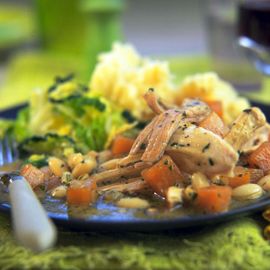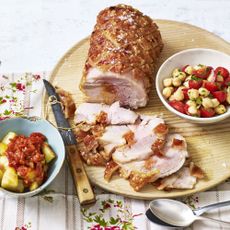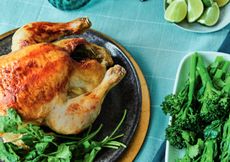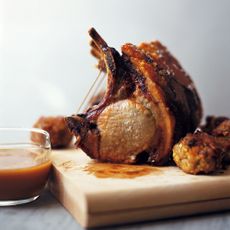Method
Preheat the oven to 180 C, 160 C (fan oven), 350 F, gas 4. In a frying pan, heat 1tbsp of the oil, add the pork, and season. Brown for 10 minutes on each side.
Meanwhile, heat the remaining oil in a casserole and fry the swede, ginger, onion and garlic for 5 minutes. Remove from the heat and stir in the cider vinegar, mustard and stock.
Add the pork to the casserole and bring to the boil. Cover and cook for 1½ hours or until the meat falls off the bone.
Rinse the cannellini beans under cold, running water, then spoon around the meat. Stir in the tarragon. Return the pot roast to the oven and cook, uncovered, for 30 minutes.
Taste the stock and season again, if necessary. Separate the meat from the bone and carefully spoon the pork and juices into a deep bowl and serve.
Ingredients
- 2tbsp vegetable oil
- 1.25kg (2lb 12oz) leg of pork, with the bone in
- 1 medium swede, trimmed and cut into 1cm (½in) cubes
- 25g (1oz) fresh root ginger, peeled and finely chopped
- 1 onion, finely chopped
- 1 garlic clove, chopped
- 100ml (4fl oz) cider vinegar
- 3 heaped tsp English mustard powder
- 100ml (4fl oz) pork or vegetable stock
- 400g can cannellini beans
- 2tbsp tarragon, roughly chopped
Top Tip for making Phil Vickery’s Pot Roast Leg of Pork with Cider Vinegar and Mustard
Chef’s secrets 1) English mustard powder works best here, rather than made mustard – it will be far more pungent. 2) Many pork producers now offer mail order, and whatever you do, buy British. The British Meat Quality Standard Mark guarantees that the pork has been produced to the highest standards of food safety and animal welfare. 3) You could use a hand of pork or a cut from the shoulder instead of the leg, but these tend to be more fatty.
-
 Chocolate and hazelnut roulade
Chocolate and hazelnut rouladeThis chocolate and hazelnut roulade comes with an optional Baileys Irish cream liqueur filling for an extra, festive twist
By Jen Bedloe Published
-
 Baileys Cheesecake
Baileys CheesecakeThis no-bake Baileys cheesecake is so easy to make and perfect for cream liqueur lovers, plus it takes just 40 minutes to prepare
By Jess Meyer Published
-
 Chocolate torte with Baileys cream and salted praline
Chocolate torte with Baileys cream and salted pralineServe this rich Chocolate torte with Baileys cream and salted praline for a festive dessert that makes a popular alternative to Christmas pudding
By Jen Bedloe Published
-
 Is Apple Cider Vinegar a true story? The real tale behind Netflix's influencer scam drama
Is Apple Cider Vinegar a true story? The real tale behind Netflix's influencer scam dramaApple Cider Vinegar tells the story of Belle Gibson, an influencer who claimed a healthy diet plan cured her cancer - but how much of the drama is true?
By Lucy Wigley Published
-
 Who is Belle Gibson and where is she now? The scandalous inspiration behind Netflix's Apple Cider Vinegar
Who is Belle Gibson and where is she now? The scandalous inspiration behind Netflix's Apple Cider VinegarNetflix has dramatised the shocking story of influencer Belle Gibson - but what happened to Belle and where is she now?
By Lucy Wigley Published
-
 Hosting a dinner party? Gwyneth Paltrow’s chic hexagonal plates are the contemporary touch that will elevate your table
Hosting a dinner party? Gwyneth Paltrow’s chic hexagonal plates are the contemporary touch that will elevate your tableThe modern style will give your table setting a chic and sleek update
By Charlie Elizabeth Culverhouse Published



